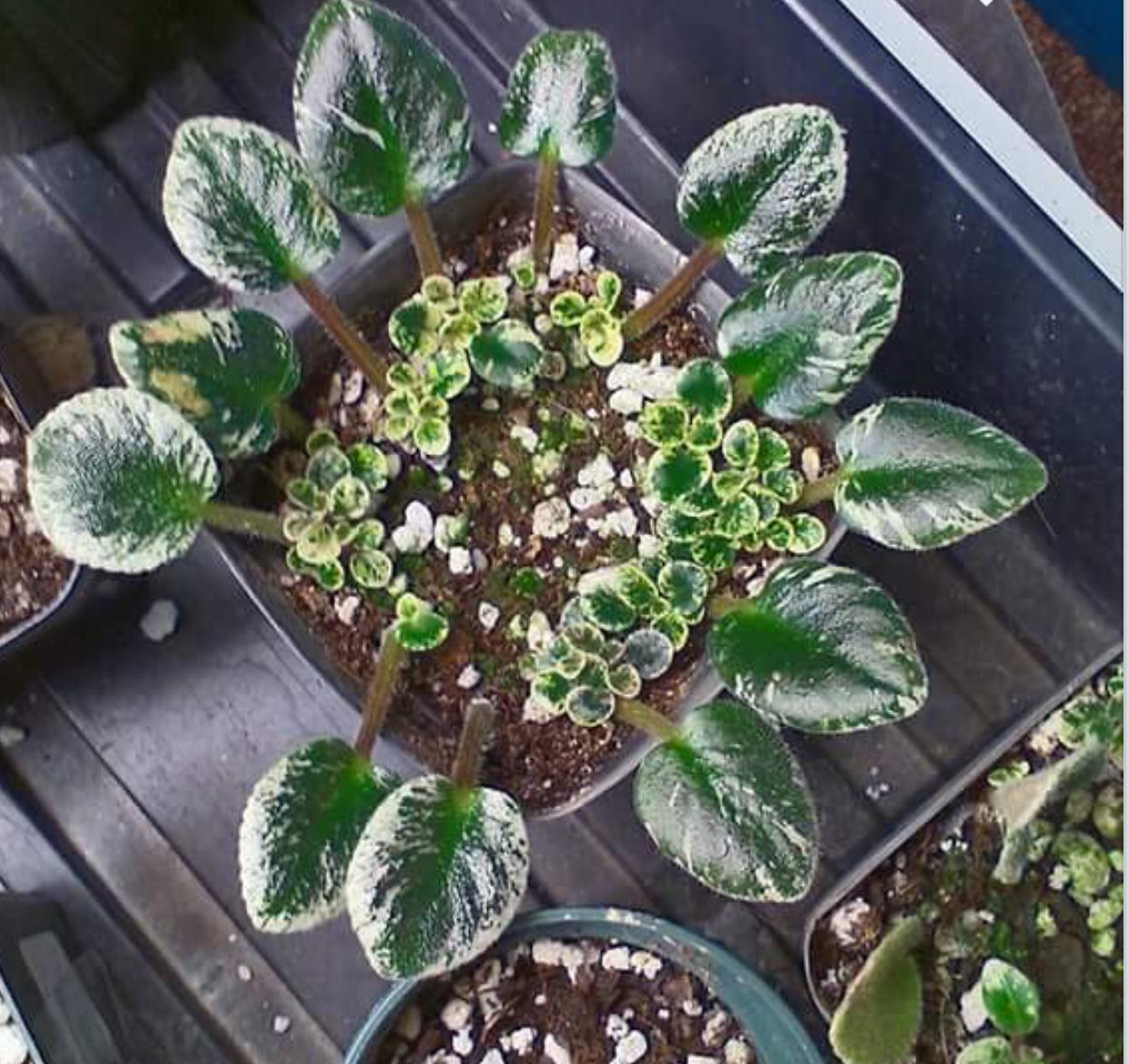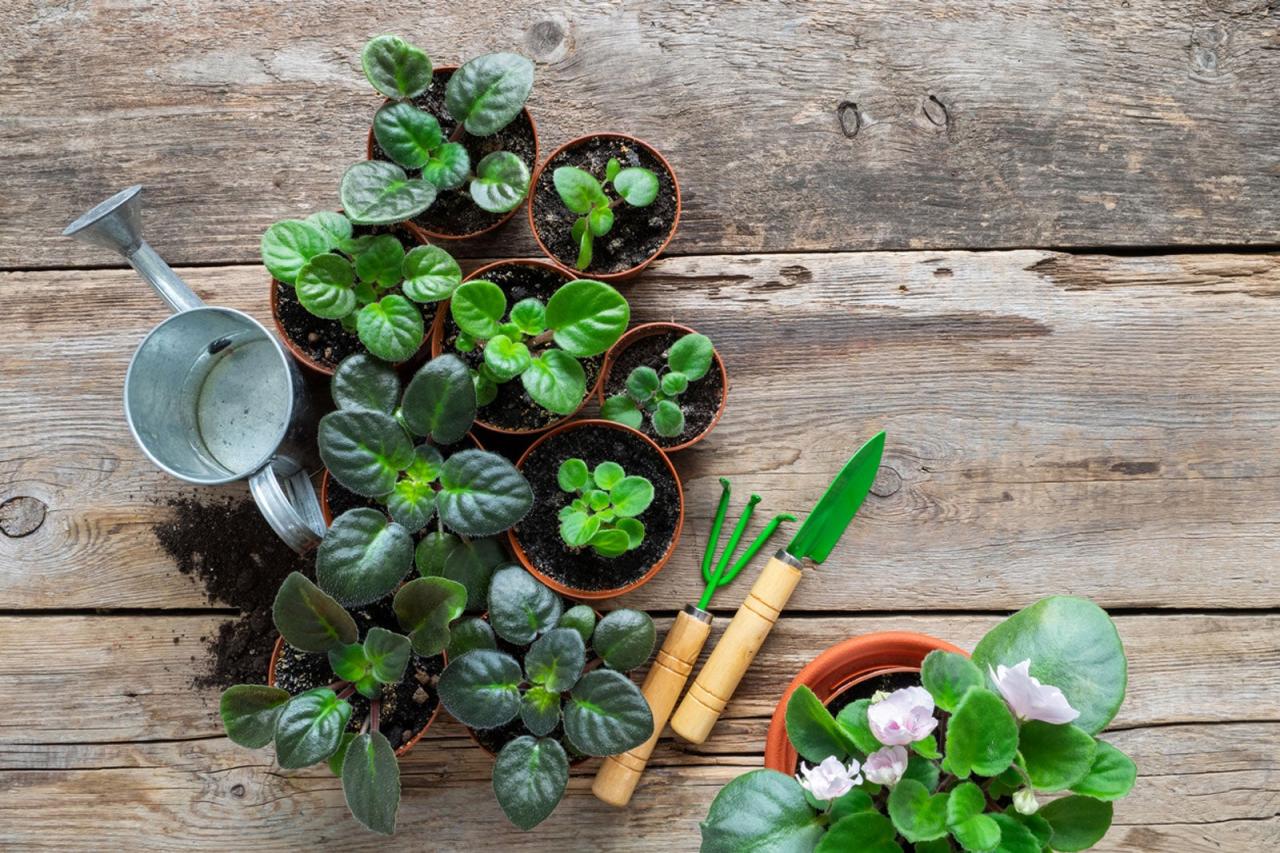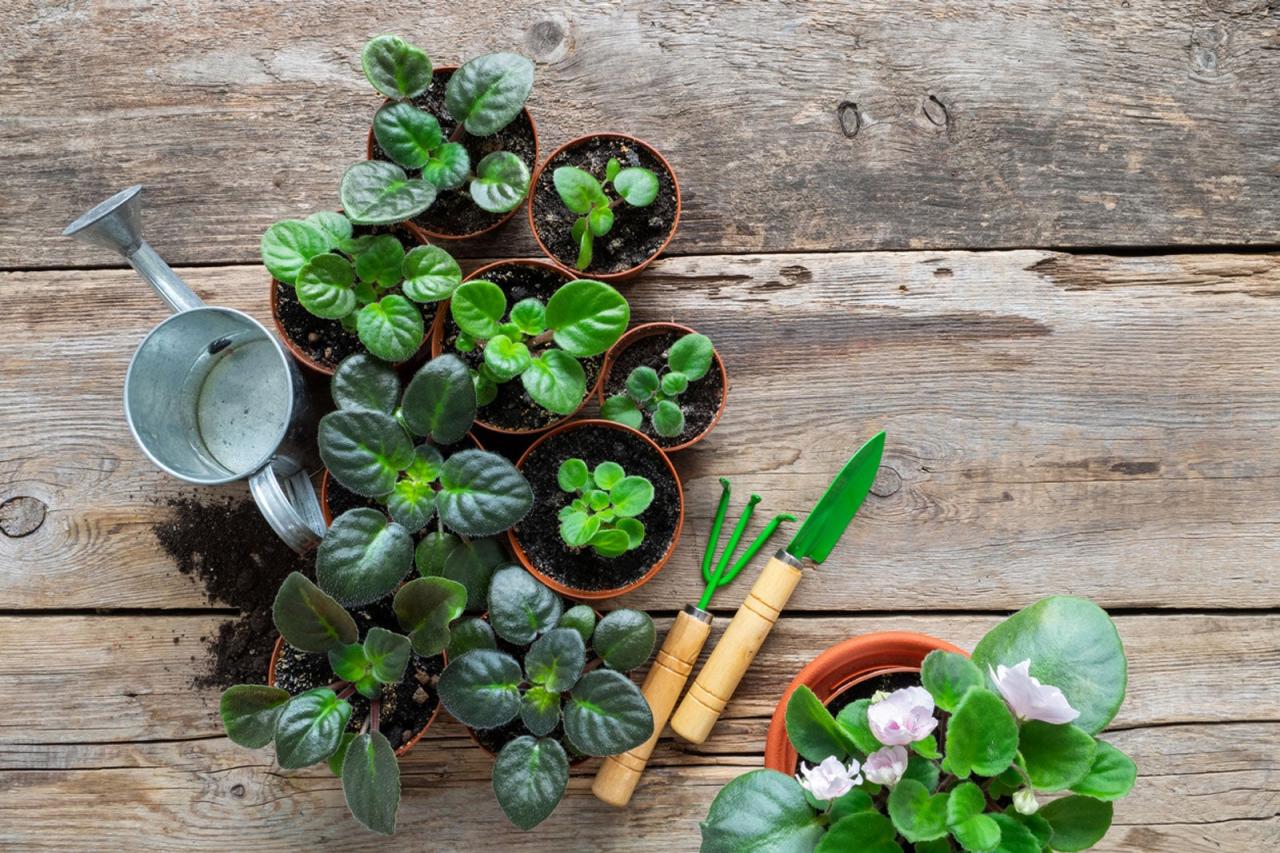How to Propagate African Violets in Water Like a Gardener – African violets are beloved houseplants known for their vibrant blooms and delicate foliage. While they can be propagated through cuttings, a simple and rewarding method is to grow them in water.
This technique allows you to witness the mesmerizing process of root development firsthand, a truly captivating experience for any gardener.
This guide will walk you through the steps of propagating African violets in water, providing valuable tips and insights to ensure success. From selecting the right leaf to nurturing root growth, you’ll learn everything you need to know to propagate these beautiful plants like a seasoned gardener.
Introduction: How To Propagate African Violets In Water Like A Gardener
African violets, with their delicate blooms and velvety leaves, are beloved houseplants cherished for their beauty and relatively easy care. These compact plants, native to Tanzania and Kenya, are a popular choice for indoor gardeners due to their vibrant colors and ability to thrive in a range of indoor environments.
Propagating African violets is a rewarding experience that allows gardeners to multiply their collection and share these beautiful plants with others. While traditional methods like leaf cuttings and division are common, propagating African violets in water offers several advantages, including:* Simplicity:Water propagation eliminates the need for soil, making it an accessible and straightforward method for beginners.
Faster Growth
Roots develop quickly in water, leading to faster plant establishment compared to traditional methods.
Clear Visibility
The process of root development is easily observable, allowing gardeners to monitor progress and intervene if necessary.This guide provides a comprehensive overview of how to propagate African violets in water, empowering gardeners of all experience levels to successfully grow new plants from cuttings.
Choosing the Right Leaf for Propagation
Selecting the perfect leaf is crucial for successful African violet propagation in water. Just like a gardener chooses the best seeds for planting, you need to choose the right leaf to ensure a healthy and thriving new plant.
Characteristics of a Healthy Leaf
The ideal leaf for propagation is healthy, mature, and free from any signs of disease or pests. Here’s what to look for:
- Color:The leaf should have a vibrant, healthy green color. Avoid leaves that are pale, yellowed, or have brown spots.
- Texture:The leaf should be firm and slightly stiff to the touch. Avoid leaves that are limp or wilted.
- Size:Choose a leaf that is at least 2-3 inches long and has a healthy petiole (the stalk that connects the leaf to the plant).
- Location:Select a leaf from the lower part of the plant. These leaves are usually more mature and have a higher success rate for propagation.
Importance of Healthy and Mature Leaves
Healthy and mature leaves are essential for successful water propagation because they contain the necessary nutrients and energy reserves for the new plant to develop. Leaves that are unhealthy or immature may lack these vital resources, making it difficult for the new plant to grow.
Tips for Identifying the Best Leaves for Propagation
- Inspect the entire plant:Look for signs of pests or disease before selecting a leaf.
- Avoid leaves that are too young or too old:Young leaves may not have enough energy reserves, and old leaves may be past their prime.
- Examine the petiole:The petiole should be firm and free of any damage.
Preparing the Leaf for Propagation
Now that you have chosen the perfect leaf for propagation, it’s time to prepare it for its watery journey. This step is crucial for successful rooting and involves making a clean, precise cut and removing any excess leaves or stems.
Preparing the Leaf for Water Propagation
The key to preparing the leaf for water propagation is a clean, precise cut. A sharp, sterile blade or scissors is essential to avoid damaging the leaf and increasing the risk of infection.
- Using a sharp, sterile blade or scissors, make a clean cut at a 45-degree angle just below the leaf node. The leaf node is the point where the leaf attaches to the stem, and it contains the dormant buds that will develop into roots.
- Remove any excess leaves or stems below the cut. This will help to prevent rot and promote healthy root growth.
- If the leaf has multiple leaves attached, remove all but the largest, healthiest one. This will help to conserve energy and direct it towards root development.
Setting Up the Water Propagation System

Setting up a water propagation system for African violets is a simple process that requires minimal materials and effort. A clear glass or jar is all you need to observe the rooting process and ensure the plant receives adequate light.
The container should be large enough to accommodate the leaf and allow for water changes without disturbing the leaf.
Using a Clear Glass or Jar, How to Propagate African Violets in Water Like a Gardener
A clear glass or jar is the ideal container for water propagation because it allows you to monitor the rooting process. You can easily observe the formation of roots and ensure that the water level remains adequate.
- A clear glass or jar provides visibility, allowing you to monitor the rooting process and ensure that the water level remains adequate.
- Select a container large enough to accommodate the leaf without overcrowding and allow for easy water changes.
- The container should be clean and free of any residue that could contaminate the water or harm the leaf.
Filling the Container with Water
The water used for propagation should be clean and free of impurities that could harm the leaf. It is important to change the water regularly to prevent the growth of bacteria and algae.
- Fill the container with clean, filtered water, leaving about an inch of space at the top to allow for air circulation.
- Avoid using tap water, as it may contain chlorine and other chemicals that can harm the leaf.
- Use distilled or filtered water to ensure the water is clean and free of impurities.
- Change the water every 3-4 days, or more often if the water becomes cloudy or discolored.
Using Clean and Filtered Water
Using clean and filtered water is crucial for successful propagation. Impurities in water can hinder root development and increase the risk of fungal infections.
- Tap water often contains chlorine and other chemicals that can be harmful to plants.
- Distilled or filtered water removes these impurities, providing a clean and safe environment for root growth.
- Changing the water regularly prevents the accumulation of bacteria and algae, which can harm the leaf and hinder rooting.
Placing the Leaf in Water
Now that you’ve prepared your African violet leaf for propagation, it’s time to place it in the water. This step is crucial for initiating root growth and ensuring the leaf thrives in its new environment.
Submerging the Leaf
The depth to which you submerge the leaf is essential for its successful propagation. You should aim to submerge only the cut end of the leaf in the water. This allows the leaf to absorb moisture without risking rot or fungal growth.
Submerging the entire leaf can lead to rotting, which can hinder root development.
- Ideal Depth:A depth of about 1/2 inch (1.25 cm) is usually sufficient to keep the cut end of the leaf submerged.
- Monitoring Water Levels:Regularly check the water level and add more as needed to maintain the desired depth.
Ensuring Stability
To ensure the leaf remains upright and stable in the water, you can use a few techniques:
- Glass Jar or Vase:A glass jar or vase with a narrow opening can provide natural stability for the leaf.
- Small Rocks or Pebbles:Place a few small rocks or pebbles at the bottom of the container to hold the leaf in place.
- Toothpicks:Insert toothpicks into the leaf near the base and rest them on the rim of the container. This method provides support without directly touching the water.
Providing Optimal Conditions for Root Development
Creating the ideal environment for your African violet leaf cuttings to develop strong roots is crucial for successful propagation. A few key factors contribute to healthy root growth.
Ideal Temperature and Humidity
Maintaining the right temperature and humidity levels is essential for optimal root development. African violets thrive in warm, humid environments. The ideal temperature range for root growth is between 70-75°F (21-24°C). Higher temperatures can stress the cuttings and hinder root formation.
Propagating African violets in water is a simple and rewarding method, much like the meticulous art of Bonsai , where patience and attention to detail are key. Just as a bonsai artist carefully shapes a tree, you’ll nurture your violet cutting in water, ensuring its roots develop strong and healthy before transferring it to soil.
This technique allows for a greater understanding of the plant’s growth process, mirroring the bonsai master’s intimate knowledge of their miniature trees.
Humidity plays a significant role in root development. Aim for a humidity level of around 50-60%. You can achieve this by placing the propagation container in a humid environment, such as a bathroom or a greenhouse. Alternatively, you can create a mini-greenhouse by covering the propagation container with a plastic bag or dome.
Monitoring Root Growth and Development
Patience is key when propagating African violets in water. While the process is relatively straightforward, it requires consistent observation and care to ensure successful root development. Regularly monitoring the leaf and water for signs of growth and change will help you understand the progress of the propagation.
Observing Root Growth
The emergence of roots is a significant milestone in the propagation process. To monitor root development, carefully observe the leaf’s base in the water.
- Initially, you may notice a slight discoloration or a cloudy appearance in the water around the leaf’s base, indicating the beginning of root formation.
- Within a few weeks, you should start seeing tiny, white rootlets emerging from the leaf’s stem.
- As the roots grow longer, they will become more visible and may even branch out.
Typical Timeline for Root Formation
The time it takes for African violet leaves to develop roots in water varies depending on factors such as the leaf’s health, water quality, and environmental conditions.
- In general, you can expect to see roots forming within a few weeks, but it can sometimes take up to a month or more.
- The appearance of the first rootlets is a good indicator that the propagation is on track.
Changes in the Leaf and Water
During the propagation process, you may observe changes in the leaf and the water.
- The leaf may appear slightly wilted or discolored as it focuses its energy on root development. This is normal and should not be cause for concern.
- The water may become slightly cloudy or discolored as the leaf releases nutrients and minerals. It’s important to change the water every week or two to prevent the growth of bacteria and algae.
Transplanting the Rooted Leaf into Soil
Once your African violet leaf has developed a healthy root system, it’s time to transplant it into soil. This process involves carefully transferring the rooted leaf from its water environment to a suitable potting mix, ensuring the roots are not disturbed.
Preparing the Potting Mix and Pot
African violets thrive in a well-draining, slightly acidic potting mix. A good choice is a mix specifically formulated for African violets or a general-purpose potting mix with added perlite or vermiculite to improve drainage. The pot should be small, with a diameter of 2-3 inches, and have drainage holes to prevent waterlogging.
Transplanting the Rooted Leaf
- Prepare the pot:Fill the pot with the chosen potting mix, leaving about an inch of space at the top. Gently tamp down the mix to create a firm base.
- Remove the leaf from water:Carefully remove the leaf from its water container. If you see any root growth on the leaf itself, gently remove them.
- Make a planting hole:Use your finger or a small trowel to create a hole in the center of the potting mix, just deep enough to accommodate the roots of the leaf.
- Place the leaf in the hole:Position the leaf in the hole, ensuring the roots are spread out and not curled or tangled.
- Backfill the hole:Gently backfill the hole with the potting mix, making sure to cover the roots completely. Do not press down too hard on the soil, as this can damage the delicate roots.
- Water the leaf:Water the newly planted leaf thoroughly, making sure the entire potting mix is moistened.
Troubleshooting Common Issues
While water propagation is generally a straightforward process, there are a few potential issues that may arise. Understanding these issues and their solutions can help you achieve successful root development and ultimately, healthy African violet plants.
Leaf Rot
Leaf rot is a common issue during water propagation. It can be caused by bacteria or fungi that thrive in moist environments.
- Signs of leaf rot include discoloration, softening, and a slimy texture on the leaf.
- To prevent leaf rot, ensure the water you use is clean and free of contaminants. It’s also important to change the water every 2-3 days to prevent bacterial growth.
- If you notice signs of leaf rot, remove the affected leaf immediately to prevent the spread of the infection. Trim away the rotted portion of the leaf and place the remaining healthy part in fresh water.
Mold Growth
Mold can grow on the surface of the water or on the leaf itself. It’s often a result of stagnant water or excessive humidity.
- To prevent mold growth, change the water regularly, keeping it clean and fresh.
- You can also add a few drops of hydrogen peroxide to the water, which helps to kill mold and bacteria.
- If you notice mold on the leaf, carefully remove it with a clean cloth or cotton swab. Avoid using harsh chemicals that can damage the leaf.
Stunted Growth
Stunted growth can be caused by several factors, including insufficient light, low humidity, or nutrient deficiencies.
- Ensure the leaf receives bright, indirect light for at least 6-8 hours daily. Avoid placing the leaf in direct sunlight, which can scorch the leaves.
- Maintain a high humidity level around the leaf. You can achieve this by placing the container on a pebble tray filled with water or using a humidifier.
- After a few weeks, you can add a few drops of liquid fertilizer diluted to half strength to the water. This provides essential nutrients for root development.
Root Damage
While it’s less common, root damage can occur if the leaf is mishandled or if the water becomes contaminated.
- Handle the leaf gently during propagation to avoid bruising or damaging the roots.
- Use clean water and change it regularly to prevent bacterial growth that can damage the roots.
- If you notice any signs of root damage, such as discoloration or rot, trim the affected areas with a sterile knife or scissors.
Conclusion

Propagating African violets in water is a simple and rewarding method for growing new plants. It offers a clear view of root development and allows you to intervene if necessary.
Key Steps in Water Propagation
The key steps involved in propagating African violets in water are as follows:
- Choose a healthy, mature leaf.
- Prepare the leaf by removing the bottom inch and making a shallow cut at the base.
- Set up a water propagation system using a clean jar or container filled with distilled or purified water.
- Place the prepared leaf in the water, ensuring the cut end is submerged.
- Provide optimal conditions for root development, including bright indirect light and room temperature.
- Monitor root growth and development regularly.
- Once roots are established, transplant the rooted leaf into a suitable potting mix.
Closing Notes
Propagating African violets in water is a delightful and accessible way to expand your plant collection. By following these steps, you’ll not only cultivate new plants but also gain a deeper understanding of the plant’s life cycle. Embrace the journey of nurturing these delicate blooms from leaf to thriving plant, and enjoy the rewarding experience of propagating your own African violets.
FAQ Corner
What is the best time of year to propagate African violets in water?
African violets can be propagated in water year-round, but spring and summer are ideal times as they offer warmer temperatures and longer daylight hours, which promote faster root development.
Can I use tap water for propagation?
While tap water can be used, it’s recommended to let it sit for 24 hours to allow chlorine to dissipate, as it can harm the plant. Filtered or distilled water is ideal.
What if my leaf starts to rot during propagation?
Leaf rot can occur if the water is not changed regularly or if the leaf is submerged too deeply. Remove the leaf from the water, trim any rotted parts, and place it in fresh water. Consider adding a small amount of activated charcoal to the water to help prevent rot.
How long does it typically take for roots to develop?
Root development can take anywhere from a few weeks to a couple of months, depending on factors such as temperature, humidity, and leaf health. Patience is key!
